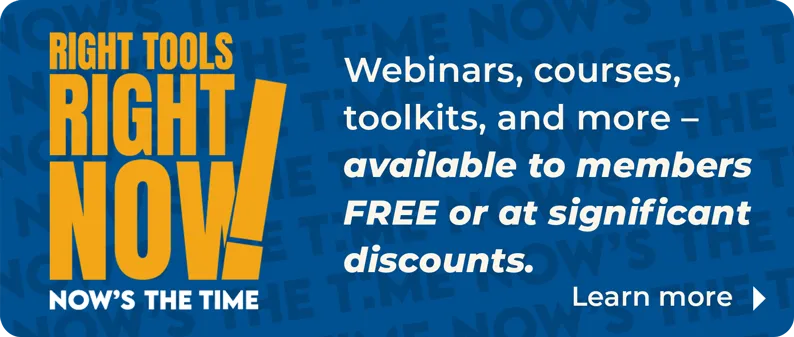Forward-looking real estate industry pundits predict the future of your association and how to plan for smooth sailing today.
When you did strategic planning five years ago, did you foresee today’s still-booming market? Did you conceive of today’s alternative online business models or the threat of banks trying to get into real estate?
Chances are your vision wasn’t that perfect. This is what makes strategic planning so difficult. So RAE turned to the experts—people whose job it is to forecast the future of real estate—and asked them what Realtor® associations would look like five years from now. More important, we asked them what you should do today to make sure your association succeeds in the future. So, sit back and let the best and the brightest predict your future.
Decision-making on a
dime
Dadie Perlov, founder and principal of the Consensus Management Group, a consulting firm to trade and professional associations.
AEs will have to make decisions less on what’s good for the association and more on what’s best for members. More often than before, what’s best for members may conflict with what’s best for the organization. For example, a number of small local associations will have to give way to larger merged associations focusing less on locale than they have in the past.
All of this may require a different kind of member leadership, one that’ll be extraordinarily nimble and quick and totally focused on strategic decisions.
Decision-making no longer can go from committee to leadership to staff back to leadership. The association must turn on a dime based on defensible criteria.
To achieve this, members will have to understand their role. They should only guide decisions, not make them. That means AEs will need to spend more time deciding the benchmarks that determine how decisions will be made. Once that’s done, it’ll be easier for leadership and committees to make decisions quickly.
For AEs, the day of totally deferring to members is over; you can work with members, but you have to demonstrate real leadership and accountability.
Are AEs fiddling while Rome burns?
Jerry Matthews, adviser to real estate associations, companies, and practitioners on developing their future. Former association executive of the Florida Association of Realtors®.
AEs need to focus on services they can deliver and on staffing fully in the future if they want to be more relevant. For instance, the MLS: Is it still relevant today? AEs need to ask, How will the fact that consumers are driving the use of technology change the way society looks at real estate and how it interacts with Realtors®?
If the MLS can provide members with information consumers don’t have, then the MLS still will exist. But the MLS will need to feature a much deeper set of information—projections of building in the area, for example—things the consumer doesn’t need to know but members should.
AEs should be worried that they’re fighting over little things and might lose sight of the big picture. Members are made to join many organizations, pay many fees, and find many ways to access the MLS. But as associations struggle over MLS territories and borders, they may wake up one day and find that some entity outside organized real estate has solved the problems with MLS territories and boundaries. It’s like in football, when a team focuses all its attention on the center, and its opponent does an end-run around the middle.
Something’s going to blow!
Stefan Swanepoel, managing partner of Realsure, a consulting and research firm, and chairman and CEO of RealtyU, a real estate education center.
Associations have to keep up with changes in technology. So many members have been bitten by buying products or services that are antiquated within 12 months. There’s so much technology thrown at salespeople, they’re getting fed up and saying, “Please stop this! Tell me what I need, and help me integrate it all, because it doesn’t always work together.”
The association should see itself as a facilitator, bringing some level of technological uniformity to the industry. It also should take a stronger role in evaluating all the devices and helping members bring the systems together.
Associations should be concerned about the need to protect members’ personal data as well as the personal data in their MLS. Many don’t yet have secure MLS sites or even understand what they need to do. These people need to get their heads around the CAN-SPAM Act, which governs unsolicited e-mails, or the Fair and Accurate Credit Transactions Act, which dictates how entities must control consumers’ personal data.
Associations are going to have to make sure data is safe and secure, because somewhere, something’s going to explode. We’re going to have a major security breach and it’ll be a huge problem.
What a drag it is getting
older
John Tuccillo, real estate industry consultant and principal of John Tuccillo Associates, Inc.
The biggest association challenge will be recruiting and integrating younger members into the governing structure. Real estate is an aging profession, and it’s servicing a population that’s getting younger and younger. Associations have had it easy because they’ve had baby boomers, who are chronic joiners. What’s life like after the older joiners and participators are gone? They’re being followed by a generation that’s jealous of its time, and the result is that associations will find it harder to staff their model.
Associations will have to find a way to bring young people into their structure. So by necessity, associations will become more staff directed and focus less on member direction because fewer members will want to participate. That’ll give a lot more long-term stability to association programs because the people having the biggest say will be those making long-term decisions.
To be in touch with younger members, associations must find out what benefits younger people see in the Realtor® organization and then build a business model around those benefits. Then they’ll need to move to a governing structure that makes as efficient use of members’ time as possible, eliminating meetings for meetings’ sake. Younger people want time to be economized.
The ladder should fall
Adorna Carroll, co-owner of Dynamic Directions, a consulting firm that specializes in sales and leadership training, and owner of Realty 3 in Berlin, Conn.
What associations need to identify is whether they’re responsive enough to members’ needs. The current governance structure isn’t drawing the highest-quality members. The ladder system, in which members start at one position, then move up one rung at a time until they eventually become president, doesn’t encourage the best talent, because the climb to the top is so time-consuming. Ultimately, the bylaws that lay out the timetable need to change.
Staff members need to seek out the best talent for leadership instead of looking to fill seats. They also need to make sure that leaders are doing business on a daily basis rather than just being association junkies. Associations will have to be selective about meetings and allow for technology, such as videoconferencing, to avoid wasting members’ time. They may also want to look at voting processes so that bylaws incorporate electronic and proxy voting.
Volunteer members also need to remember that they’ve hired the AE to run the association and they shouldn’t micromanage. Many members don’t know or understand the value of the AE. Members need to understand that the AE is our most valuable business partner. It’s crucial that budgets include the opportunity for our executives to get the professional development opportunities that are available.
9 quick takes from the experts
You can learn so much from the experts that we hate to let even one important point slip by. So here, in no particular order, are nine additional thoughts from the experts that’ll help you strategize for the future.
1. MLS rules and regulations, including the Code of Ethics, need to get tougher. Members are losing trust in associations on this issue. People are allowed to do naughty things with few repercussions. For instance, members sometimes think it’s worth it to pay a fine for holding a listing out of the MLS so they can sell it themselves. Other salespeople don’t complain because they don’t feel the penalty will make a difference. When that happens, the rest of the members lose trust.—Adorna
Carroll
2. Every association needs a technology expert, whether on staff or under contract. If you can get an expert on your side, you can keep up with technology. Small associations might want to rely on their state association or find someone locally. But you can’t not be wired in a world where everybody else is plugged in.—John Tuccillo
3. One thing that always amazes me is the amount of attention we pay to participants of meetings and events. Smart AEs will survey members who don’t come to find out why they chose not to participate and what services they’d like. They may be happy and want to be left alone, but unless you ask, you’ll never know.—Dadie
Perlov
4. Associations need strong leadership. It used to be that the AE was supposed to be nice. It’s no longer enough to be nice. You must be a leader. If AEs aren’t strong leaders, they need to be replaced or moved to a position where their skills will be better used.—Stefan Swanepoel
5. When you’re doing your strategic thinking, get way outside the Realtor® organization. Put up your antennae and look for trends outside the business. Don’t dismiss out-of-hand wild and crazy ideas. Think twice and ask, If this caught on, how would it change my world?—Jerry Matthews
6. Some associations don’t serve their members because they’ve become political playing fields, with members who are invested with self-interest and an association that has lost track of what members want. But if you work with your leadership team to plan where the association is going over several years, when a new president comes in a few years down the road, he or she will have been involved in creating the plan and will be less likely to change it during the presidency.—Stefan Swanepoel
7. AEs should worry about irrelevance in the future. With board of choice and acquisitions, I see the danger of some associations ceasing to exist, and I don’t think they’ll go out of business on their own. So you have to worry about knowing what makes your members join and what makes members stay, then build your association around those things.—John
Tuccillo
8. In the future, it’ll be wise to do fewer things but do them extremely well. AEs need to evaluate the broad list of programs offered by most associations, because many of the traditional things associations have offered are now available to members elsewhere, largely online.—Dadie Perlov
9. Remember there’s a personal side to this business as well as a personal impact when there’s a tremendous change. So if challenges come in the future, you need to have another AE, a good friend, a college roommate—somebody you can talk to. When the market turns, you’re going to need a friend.—Jerry Matthews








